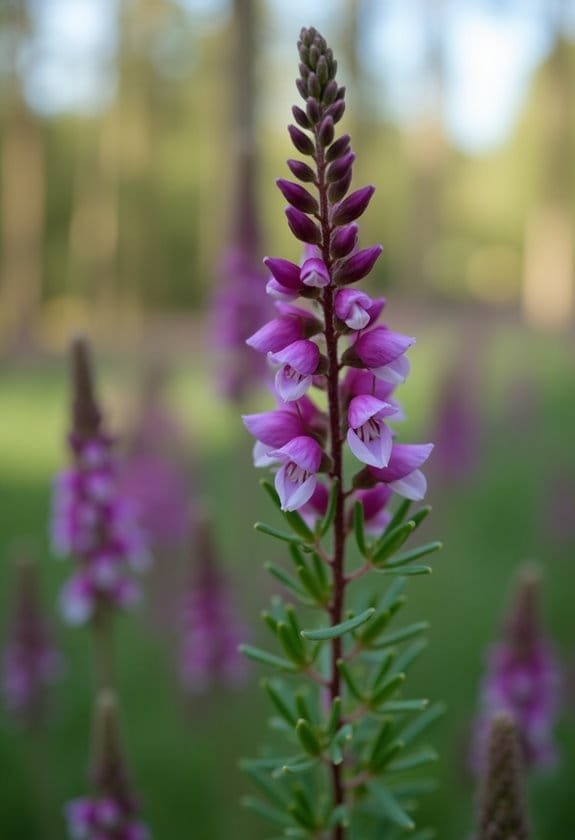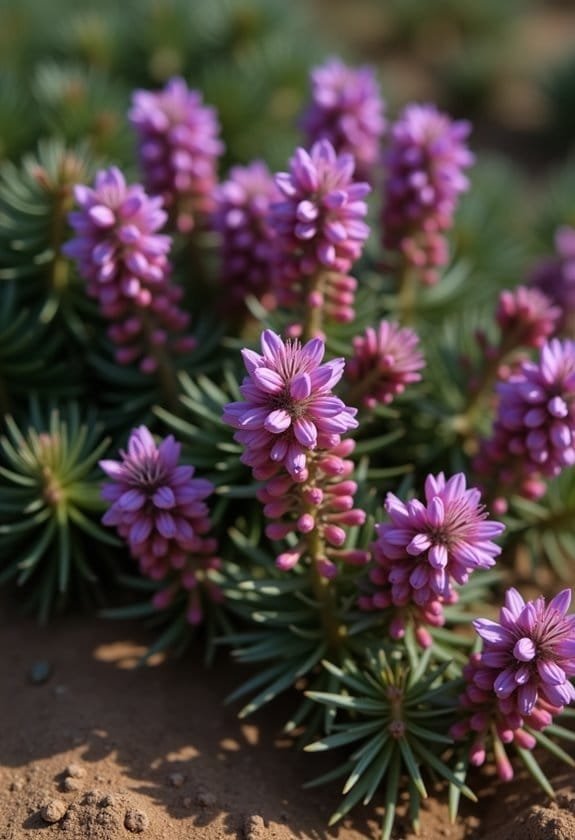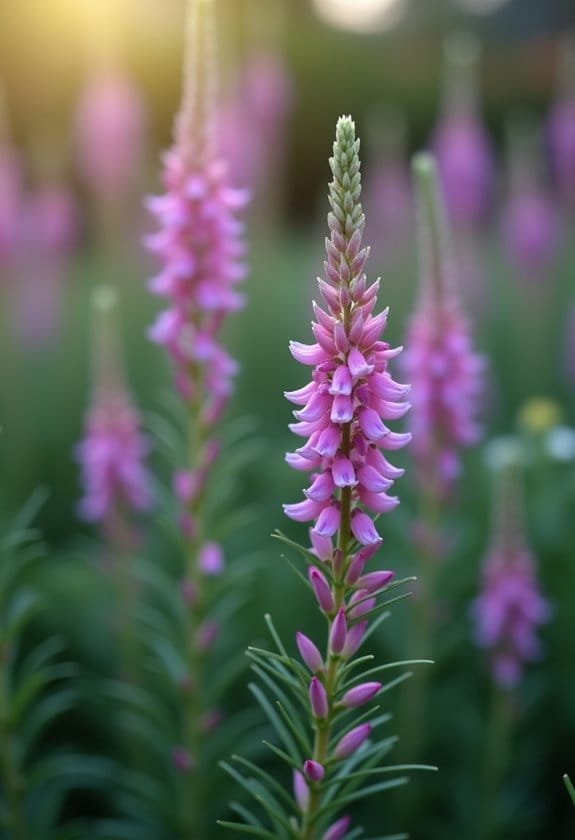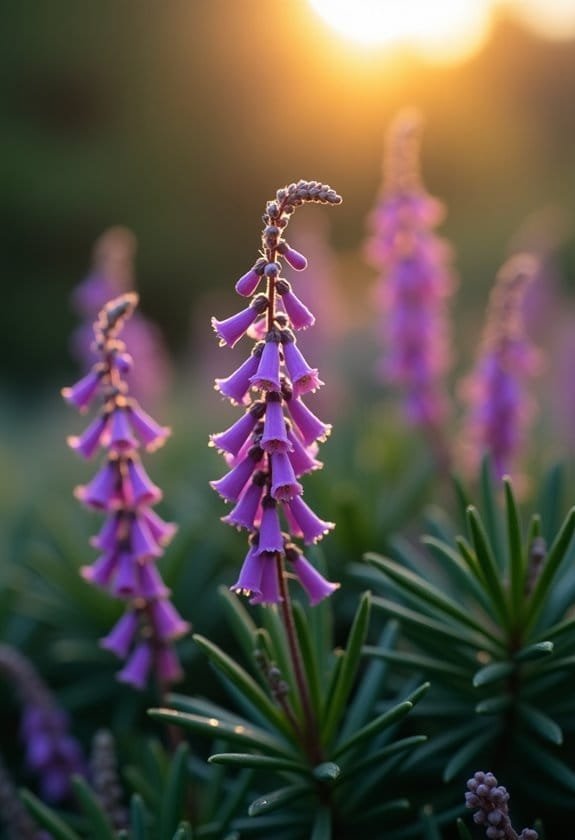Bell heather (Erica cinerea) is a compact evergreen shrub native to Western Europe that's earned the prestigious RHS Award of Garden Merit. It's known for its stunning magenta bell-shaped flowers that bloom from June to September against dark green needle-like foliage arranged in whorls of three. Growing just 10 inches tall with a 24-inch spread, this hardy plant thrives in acidic, well-draining soils and full sun exposure. It's not just ornamental – Bell heather ranks among Britain's top five nectar producers, making it an essential resource for bees, butterflies, and other pollinators. Understanding its specific growing requirements reveals the full potential of this garden gem.
Main Points
- Bell Heather is a compact evergreen shrub with dark green needles and magenta bell-shaped flowers blooming from June to September.
- Native to Western Europe, this plant grows 10 inches tall, spreads up to 24 inches, and thrives in hardiness zones 5-8.
- Requires acidic soil (pH 4.5-6.0), full sun exposure, and well-draining conditions for optimal growth and flowering.
- Serves as a vital nectar source for pollinators, ranking among Britain's top five nectar-producing plants.
- Annual pruning after flowering maintains shape, while consistent moisture and proper drainage prevent common root diseases.
Introduction

Bell Heather (Erica cinerea) stands as a remarkable dwarf evergreen shrub, combining compact size with striking ornamental appeal in gardens across western Europe.
Its distinctive features include dark green needle-like foliage arranged in neat whorls of three and vibrant magenta bell-shaped blooms that grace the plant from June through September.
The species has earned the prestigious Royal Horticultural Society's Award of Garden Merit for its exceptional garden performance, drought tolerance once established, and significant contribution to pollinator populations as a premier nectar source.
Common Name
The striking Bell Heather, scientifically known as Erica cinerea, stands out among heathland plants with its vibrant magenta blooms and compact growth habit. This distinguished evergreen shrub has earned its common name from the delicate, bell-shaped flowers that adorn its stems during the summer months, creating a magnificent display from June through September.
The plant's recognized excellence in gardens and landscapes has been formally acknowledged through the prestigious Royal Horticultural Society's Award of Garden Merit. While Bell Heather serves as its primary common name throughout Western Europe, local variations of the name exist across different regions where it naturally occurs.
The diminutive yet robust nature of this heather, growing to a modest height of 10 inches while spreading up to 24 inches wide, has made it a favorite among gardeners seeking low-maintenance ground cover options. In its native habitat, from
Scientific Name
Known scientifically as *Erica cinerea*, this distinguished heathland species derives its specific epithet 'cinerea' from the Latin word meaning "ash colored" – a reference to its grayish foliage.
The scientific classification places this charming plant within the genus Erica which encompasses numerous heather species found across Europe and beyond.
The binomial nomenclature of *Erica cinerea* reflects both its taxonomic relationship to other heather species and its distinctive characteristics. Native to Western Europe, particularly Britain and Ireland, this species exhibits the quintessential features of its genus, including fine needle-like leaves arranged in precise whorls of three, measuring 4-8 mm in length.
The plant's scientific name has become well-established in botanical literature, helping researchers and gardeners precisely identify this species among its relatives.
The formal classification accurately describes a plant that thrives in well-drained soils and reaches heights of up to 50 cm, producing its characteristic dark purple-pink, bell-shaped blooms during the summer months.
This scientific designation has remained stable, facilitating consistent identification across its natural range and in cultivated settings.
Overview
Among Britain's most cherished heathland plants, *Erica cinerea* captivates with its compact form and vibrant magenta blooms. This diminutive evergreen shrub, reaching heights of merely 10 inches while spreading up to 24 inches wide, creates a stunning display in gardens and natural landscapes alike. Its resilience and adaptability make it a favorite in rock gardens and sandy soils, thriving even in challenging conditions. A staple in the Dorset heath plant profile, Erica cinerea not only adds visual appeal but also provides a vital nectar source for pollinators throughout the summer months. Its low-maintenance nature ensures it remains a popular choice for both seasoned gardeners and novices looking to enhance their outdoor spaces.
Its distinctive bell-shaped flowers emerge in prolific clusters from June through September, transforming landscapes into carpets of purple-pink hues.
This resilient plant has earned the prestigious Royal Horticultural Society's Award of Garden Merit, proof of its exceptional garden performance and versatility. Thriving in full sun conditions, Bell Heather demonstrates remarkable adaptability to various growing conditions, though it shows particular affinity for sandy, acidic soils with good drainage.
While the plant requires consistent moisture during establishment, it develops impressive drought tolerance as it matures.
Beyond its ornamental appeal, Bell Heather serves an essential ecological role in Western European ecosystems, ranking among the top five nectar-producing plants in the United Kingdom and providing crucial sustenance for numerous pollinator species throughout its extended blooming season.
Key Features
Bell Heather stands as a compact evergreen shrub, reaching heights of 6 to 18 inches while spreading up to 24 inches across its mature width.
Its distinctive appearance combines delicate, needle-like leaves arranged in whorls of three with vibrant magenta, bell-shaped blooms that grace the plant throughout summer.
The flowering season extends from June through September, making this low-growing shrub an enduring presence in gardens and natural landscapes during the warmer months.
Growth Size
This compact evergreen shrub reaches heights of 6 to 18 inches (15 to 45 cm) while spreading up to 24 inches (60 cm) wide. Its growth pattern creates a dense, mounding structure that makes it a great plant for garden borders and rock gardens, where its spreading habit provides excellent ground coverage throughout the year.
The plant's distinctive appearance comes from its fine, dark green needle-like foliage, which grows in whorls of three along the stems, with individual leaves measuring 4 to 8 mm in length. This architectural arrangement contributes to the shrub's overall compact and well-organized form, creating an attractive base for its vibrant floral display.
Bell Heather's manageable size and spreading nature make it particularly valuable in designed landscapes, where it can be used effectively to create sweeping drifts or contained focal points.
The Royal Horticultural Society has recognized these qualities with their Award of Garden Merit, acknowledging the plant's versatile dimensions and visual impact.
During its blooming period from June to September, the shrub maintains its modest height while producing an abundance of magenta, bell-shaped flowers that enhance its ornamental value.
Appearance
Distinctive bell-shaped flowers in vibrant purple-pink hues crown this compact shrub, creating a striking contrast against its dark green needle-like foliage. These delicate blooms, measuring 4 to 7 mm in length, cluster together in dense formations that transform the plant into a cascading fountain of color during its peak flowering period.
The plant's architectural structure showcases its fine, needle-like leaves, which are arranged in precise whorls of three and span 4 to 8 mm long. This unique foliar pattern, reminiscent of similar heather species found in northwestern Italy, contributes to the plant's sophisticated appearance throughout all seasons.
The evergreen foliage maintains its deep emerald shade year-round, serving as an enduring backdrop for the summer's floral display. While purple-pink blooms dominate the species, some specimens produce pristine white flowers, offering a rare and enchanting variation to the typical color palette.
The overall visual impact is that of a well-composed garden element, where the interplay between the plant's compact form, distinctive leaf arrangement, and vibrant blooms creates an engaging focal point in any landscape setting.
Flowering Season
Bursting into bloom during late spring, the enchanting flowering season of Bell Heather extends from June through September, transforming landscapes with its prolific purple-pink blossoms. The plant's flowering patterns showcase a remarkable display of bell-shaped blooms, each measuring 4-7 millimeters in length, clustered together against a backdrop of dark green foliage.
These seasonal adaptations have evolved to maximize the plant's reproductive success during the warmer months, when pollinator activity reaches its peak. The flowers emerge in dense clusters along stems adorned with distinctive whorls of three needle-like leaves, creating an eye-catching contrast that serves both aesthetic and functional purposes.
While the typical flower color remains a rich purple-pink, occasional white variants emerge, adding diversity to the species' visual appeal.
The plant's pollinator relationships are particularly significant during its flowering period, as its abundant nectar production attracts various insects. This generous nectar offering makes Bell Heather an essential component of ecological networks, supporting pollinator populations throughout the summer months while ensuring its own successful reproduction.
Growing Requirements

Bell Heather's growing requirements focus on providing full sunlight exposure and maintaining acidic, sandy soil conditions with consistent moisture levels throughout the growing season.
The plant thrives when positioned in sheltered locations that protect it from harsh winds while still allowing enough airflow to prevent fungal issues, making it particularly well-suited for rock gardens and protected coastal areas.
For ideal growth in hardiness zones 5 through 8, Bell Heather needs well-draining soil that retains sufficient moisture without becoming waterlogged, along with regular pruning to maintain its compact shape and prevent overgrowth.
Light
This sun-loving heather demands at least six hours of direct sunlight daily to reach its full potential and produce abundant blooms. The plant's sun exposure benefits extend beyond mere survival, as adequate light drives photosynthesis and promotes the development of its distinctive purple-pink flowers.
While Bell Heather thrives in full sun conditions, it's crucial to balance peak sunlight with protection from harsh environmental factors. The plant's light requirements must be considered alongside its need for shelter from strong winds, which can stress the plant and impede its growth.
In regions with intense afternoon sun, particularly in warmer zones of its growing range, partial afternoon shade may help prevent leaf scorch during the hottest months.
For gardeners in USDA zones 5 through 8, positioning Bell Heather in a south-facing location often provides ideal light conditions. This placement maximizes sun exposure while allowing the plant to establish strong roots in well-draining soil, creating a harmonious balance between light requirements and other cultural needs for successful growth.
Soil
Successful cultivation of Bell Heather hinges on providing the right soil conditions, with sandy, acidic, and well-draining soil being essential for ideal growth. The soil composition should feature a high proportion of organic matter combined with coarse sand, creating an environment that mirrors its natural heathland habitat. This plant's specific soil requirements reflect its adaptation to nutrient-poor conditions, where it has evolved to thrive.
The soil pH plays a critical role in Bell Heather's development, as it's a true calcifuge that requires acidic conditions with a pH between 4.5 and 6.0. When planted in alkaline soils, the plant often struggles with iron absorption, leading to yellowing foliage and stunted growth.
Proper soil drainage is equally crucial, as the plant requires consistent moisture while avoiding waterlogged conditions that can lead to root rot. To achieve ideal soil conditions, gardeners should incorporate ericaceous compost and maintain even moisture levels through mulching.
While Bell Heather appreciates shelter from strong winds, its root system needs well-aerated soil to establish properly and support healthy growth throughout the season.
Water
For ideal growth, providing consistent moisture levels is essential when cultivating Bell Heather, though the plant demonstrates remarkable adaptability once established. Proper irrigation techniques must maintain steady soil hydration, particularly during the vital first few years when the root system is developing. The plant's success heavily depends on finding the right balance between adequate moisture and the well-draining conditions it prefers.
While Bell Heather exhibits impressive drought resilience after establishment, careful attention to moisture retention remains critical for long-term health. Gardeners should implement regular watering schedules during dry spells, ensuring the soil never completely dries out.
Strategic placement in sheltered locations can meaningfully reduce water loss through evaporation and wind exposure, contributing to more efficient moisture management. The plant's ability to thrive in sandy, acidic soils necessitates thoughtful water management strategies, as these soil types can quickly lose moisture.
Temperature
Growing Bell Heather successfully requires careful attention to temperature conditions, as the plant thrives in temperate climates within USDA zones 5 through 8. The plant's temperature adaptations allow it to withstand both moderately cold winters and warm summers, making it a versatile choice for gardens across various regions.
In terms of temperature effects, Bell Heather demonstrates remarkable resilience when provided with appropriate shelter from harsh elements. While the plant can tolerate temperature ranges typical of its hardiness zones, it performs best when protected from extreme temperature fluctuations and strong winds that could cause temperature-related stress.
This protection is particularly important during winter months when cold winds can lead to desiccation. For ideal growth, Bell Heather benefits from consistent temperature patterns throughout the growing season, especially when combined with full sun exposure.
The plant's ability to withstand both cool and warm temperature ranges makes it an excellent choice for gardens in temperate regions, though it's vital to provide wind protection to maintain stable growing conditions and prevent temperature-induced damage to the foliage.
Pollinator Criteria
Bell Heather's abundant nectar production attracts a diverse array of pollinators, particularly honeybees and bumblebees seeking the plant's rich sugar rewards during summer months.
The distinctive bell-shaped, purple-pink flowers serve as natural beacons for moths and butterflies, making the plant a vital hub of pollinator activity in heathland environments.
These industrious insects transfer pollen between flowers while collecting nectar, ensuring successful reproduction of the plant while simultaneously contributing to the production of prized heather honey.
Attracted Pollinators
The attractive magenta blooms of Bell Heather serve as an essential nectar source for diverse pollinators throughout the summer months. The plant's nectar preferences align perfectly with the nutritional needs of various pollinating insects, making it a vital component of the UK's ecological landscape.
Bell Heather's distinctive bell-shaped flowers, clustering densely along its stems, create an efficient feeding station for multiple pollinator species. Honeybees and bumblebees demonstrate particular foraging behavior patterns when visiting these blooms, methodically working their way through the flower clusters to maximize nectar collection.
The plant's extended flowering period, from June through September, provides sustained support for pollinator diversity during critical foraging months.
The relationship between Bell Heather and its pollinators yields tangible benefits, as evidenced by the distinctive honey produced from its nectar. Moths and butterflies join the diurnal visitors in seeking out these nectar-rich blooms, contributing to the plant's status as one of Britain's top five nectar producers.
This remarkable nectar production capacity makes Bell Heather an invaluable resource for maintaining healthy pollinator populations in local ecosystems.
Pollination Method
Efficient pollination mechanisms dictate Bell Heather's reproductive success, with the plant's specialized flower structure playing an important role. The distinctive bell-shaped blooms have evolved to maximize pollination efficiency through their precisely adapted form, which guides visiting insects toward the nectar source while ensuring pollen transfer.
The flowers' design demonstrates remarkable ecological impact through its summer blooming period, which synchronizes perfectly with peak pollinator activity. When insects, particularly bees and moths, visit the flowers, they must position themselves in specific ways to access the nectar, inadvertently collecting and depositing pollen as they move between blooms.
This strategic nectar availability, combined with the plant's abundance in nutrient-poor environments, creates an essential ecological network supporting diverse pollinator populations.
The resulting pollination success is evident in the plant's widespread distribution and its significance in producing sought-after honey products.
Bell Heather's pollination method represents a finely tuned system that has evolved to benefit both the plant and its pollinators, contributing to the broader ecosystem's stability through its efficient reproductive strategy.
Care & Maintenance

Bell Heather's successful establishment begins with proper planting in sandy, acidic soil and protection from harsh winds while maintaining consistent moisture levels.
Gardeners should implement annual pruning routines after flowering, typically in fall or early spring, to prevent the plant from becoming leggy and to maintain its compact form.
The plant's adaptability makes it an excellent companion for other acid-loving species like azaleas and rhododendrons, while its low-maintenance nature allows it to thrive with minimal intervention once established.
Planting Tips
Successfully growing Bell Heather requires attention to specific planting and maintenance needs. The planting techniques for this hardy evergreen focus on creating ideal growing conditions through careful soil preparation and strategic positioning in the garden.
For proper establishment, gardeners should select a location that receives full sun exposure while offering protection from strong winds that can damage the plant's delicate structure.
The soil preparation process demands particular attention to achieving well-draining, acidic conditions, preferably incorporating sandy components that mirror the plant's natural habitat preferences.
Spacing considerations play an important role in the long-term success of Bell Heather plantings. Each specimen should be positioned 24 inches apart to accommodate their mature spread of up to 60 centimeters, allowing sufficient room for their naturally spreading growth pattern.
During the establishment period, maintaining consistent soil moisture is essential, though the plant will develop improved drought tolerance once established.
After planting, gardeners should implement a regular pruning schedule, trimming stems below spent flowers in fall or early spring to maintain the plant's aesthetic appeal and prevent untidy growth habits.
Ongoing Care
Maintaining Bell Heather's vibrant appearance and health requires three essential care practices: regular pruning, consistent moisture management, and vigilant disease monitoring.
Annual pruning techniques should be implemented either in late autumn after flowering or during early spring, focusing on removing straggly growth to preserve the plant's compact form.
Using clean, sharp shears, gardeners should trim back approximately one-third of the previous year's growth, encouraging robust regeneration and maintaining the desired shape.
Moisture management plays a fundamental role in Bell Heather's long-term health, requiring a delicate balance between adequate hydration and proper drainage.
While the plant demonstrates admirable drought tolerance once established, consistent soil moisture must be maintained, particularly during seasonal adjustments from spring to summer.
Health monitoring should focus on signs of Phytophthora root diseases, which can manifest as wilting or yellowing foliage.
Proper air circulation and strategic placement in full sun, sheltered from harsh winds, will greatly reduce disease susceptibility.
When selecting a location, prioritize areas with sandy, acidic soil that provides optimal drainage while retaining essential moisture.
Suggested Companions
While designing a vibrant garden display, pairing Bell Heather with complementary acid-loving plants creates stunning visual impact and promotes ideal growing conditions. The most successful plant combinations include Rhododendrons and Azaleas, which share Bell Heather's preference for acidic soil and create a harmonious layered effect in the landscape.
When planning these companion plantings, soil compatibility plays an essential role in ensuring all species thrive together. Gardeners should maintain approximately 24 inches of spacing between Bell Heather and its companions, allowing each plant to develop its natural growth habit without competition.
Ground cover options like Creeping Thyme or Dwarf Blueberry enhance the aesthetic appeal while maximizing space utilization in the garden bed.
For best results, coordinate pruning schedules among companion plants, particularly focusing on fall or early spring maintenance for Bell Heather. This timing helps maintain the desired shape and prevents overcrowding issues.
The key to successful companion planting lies in selecting plants with similar moisture requirements, as Bell Heather's preference for well-drained soil must be considered when choosing neighboring species.
How Does Cross-Leaved Heath Compare to Bell Heather in Appearance and Habitat?
Cross-leaved heath and bell heather differ significantly in appearance and habitat. Cross-leaved heath features pale pink, bell-shaped flowers and thrives in wetter, boggy areas, while bell heather has vibrant purple blooms and prefers drier heathlands. For more crossleaved heath erica tetralix facts, its four-leaf whorls and preference for acidic soils stand out.
Common Issues
While Bell Heather typically displays robust health, it can fall victim to Phytophthora root diseases, particularly in waterlogged conditions that prevent proper drainage.
Environmental stressors, including exposure to harsh winds and inadequate moisture levels, can weaken the plant's defenses and lead to withering or stunted growth patterns.
Gardeners can prevent most issues by ensuring proper soil acidity, maintaining consistent watering schedules, and implementing strategic windbreaks, while treating any emerging problems with appropriate fungicides and careful pruning techniques.
Pests/Diseases
Bell heather's resilient nature makes it largely pest-resistant, though it can fall victim to Phytophthora root diseases in waterlogged conditions. These soil-borne pathogens can devastate the plant's root system, leading to widespread decline if left unchecked, particularly in gardens with poor drainage or excessive irrigation practices.
Effective disease prevention strategies center on maintaining ideal growing conditions, with well-drained, acidic soil serving as the cornerstone of plant health.
Pest management techniques focus primarily on cultural controls, including proper spacing to guarantee adequate air circulation and careful monitoring for early signs of trouble. When implementing soil health practices, gardeners should prioritize creating an environment that discourages pathogen development while promoting robust root growth.
Regular inspection of foliage and stems can reveal early warning signs such as unexplained wilting, yellowing leaves, or stem discoloration.
If disease is detected, immediate removal of affected plant material becomes vital to prevent its spread to neighboring plants. Maintaining proper soil pH and avoiding overhead watering further strengthen the plant's natural defenses against potential pathogens.
Solutions
Common issues with bell heather can be effectively addressed through proper cultural practices and preventive measures. The key to success lies in implementing appropriate planting techniques, which include selecting well-drained locations and maintaining adequate spacing between plants to promote ideal air circulation.
Soil amendments play an essential role in managing potential problems, particularly in areas prone to Phytophthora root diseases. Creating ideal growing conditions involves incorporating organic matter to improve drainage while maintaining the acidic soil profile that bell heather requires.
Seasonal care strategies should focus on consistent moisture management and timely pruning practices to prevent both drought stress and overgrowth issues. During the growing season, gardeners should monitor soil moisture levels carefully, ensuring the substrate never completely dries out while avoiding waterlogged conditions that can compromise root health.
Annual pruning below the spent flowers not only maintains the plant's attractive compact shape but also encourages vigorous new growth and abundant blooming. Protection from harsh winds through strategic placement near sheltering structures or companion plants can greatly reduce winter damage and promote sustained healthy growth throughout the year.
Summary

This enchanting dwarf shrub, Erica cinerea, stands out in gardens with its vibrant magenta blooms and compact growth habit. Growing to a modest height of 10 inches with a spread of 24 inches, Bell Heather offers remarkable benefits for gardening enthusiasts seeking low-maintenance yet visually striking plants.
The plant's ecological impact extends far beyond its aesthetic appeal, as it ranks among the top five nectar-producing plants in the UK, making it an essential resource for pollinators.
Its drought resilience, once established, coupled with its preference for sandy, acidic soils, makes it particularly well-suited for coastal gardens and rock gardens. While Phytophthora root diseases can pose challenges, the plant's overall hardiness and adaptability have earned it the prestigious Royal Horticultural Society's Award of Garden Merit.
This native of Western Europe thrives in full sun conditions and requires only annual pruning to maintain its attractive form.
For gardeners seeking a versatile, wildlife-friendly plant that combines ornamental beauty with ecological value, Bell Heather represents an excellent choice that delivers multiple benefits throughout its June-to-September flowering period.


